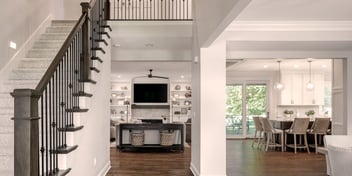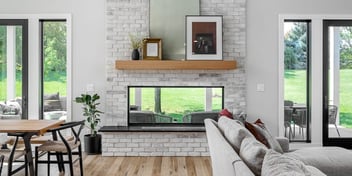6 Min Read
What Is the Best Basement Flooring Material?
When getting ready to remodel your basement, one of the essential decisions is about flooring. Many clients have told us that this feels overwhelming since there are many different options, each with its own pros and cons.
While there are books worth of technical data out there, I've tried to make things a bit simpler and give an overview of the best flooring for basements.
What Are the Main Types of Basement Flooring Options?
As a homeowner, you don't need to have an encyclopedic knowledge of basement flooring products. But it may be helpful to have an introduction to the main types of materials and know some background about their benefits and drawbacks when used in a basement.
/3515%20149th%20St-4.jpg?width=960&height=640&name=3515%20149th%20St-4.jpg)
Ceramic Tile and Porcelain Tile
Ceramic tile is made with ceramic squares that are grouted together. Porcelain tile is a commonly used kind of ceramic tile.
The benefits of ceramic tile include its heavy-duty feel, durability, and water and stain resistance. Diverse designs mean that there are tiles to match most interior design styles, and tiles can provide a polished and upscale look.
One of the main drawbacks of ceramic tile is its higher cost, including installation. Pre-installation preparation is essential since tiles will break if the concrete underneath cracks. Tiles are also hard and rigid under your feet, and unless heated, can feel very cold.
/601%20NE%20Bridge%20Creek%20Crossing-20.jpg?width=960&height=640&name=601%20NE%20Bridge%20Creek%20Crossing-20.jpg)
Carpet
Carpeting can be done with wall-to-wall carpet or with carpet tiles, which are squares of carpet arranged together. Carpet tiles are easier to remove or to use for just a specific section of your basement.
The best thing about the carpet is that it is soft underfoot and relatively warm. It is also quiet and contributes to a generally inviting and cozy feel.
Although carpet can be viewed as having potential downsides when installed in the basement, these can be overcome by having a properly working sump pump system and heating and cooling system. Carpet is often blamed when a basement has a musty odor, but it often has nothing to do with it. Preventing mold and mildew has everything to do with ensuring your HVAC system is operating properly and pulling the thick, dense air off of the floor in the cooling months. In a properly executed basement finish, carpet flooring is the least of your worries.
/IMG_6801-1.jpg?width=960&height=640&name=IMG_6801-1.jpg)
Vinyl
Vinyl flooring is made with a material called polyvinyl chloride (PVC). There are several types of vinyl flooring products.
-
Luxury vinyl planking (LVP): Luxury vinyl plank flooring uses long rectangular pieces of vinyl. The planks can connect together to form a "floating floor" that is not directly attached to the subfloor, or they can be glued down.
-
Vinyl tile: Vinyl tile flooring is similar to LVP but uses square tiles instead of planks.
-
Sheet vinyl: Sheet vinyl is rolled out to cover your basement floor. It tends to be thinner, which can show imperfections in the underlying floor.
Key advantages of vinyl flooring include its more affordable pricing (relative to tile) and ease of installation. The material is durable and highly water resistant, helping to avoid moisture problems in basements. Planks can also be easily removed if necessary.
While softer and warmer than tiles, vinyl flooring can still feel cool and hard. It is durable overall but can dent or scratch. If not properly installed, it can be uneven and show imperfections in the subfloor.
/Pinball%20Room.jpg?width=960&height=640&name=Pinball%20Room.jpg)
Engineered Wood
To the eye, engineered wood may look like hardwood flooring. However, its planks have hardwood layered on top of plywood or fiberboard. Like LVP, it can click together as a floating floor or be attached to the subfloor.
For basements, engineered wood is better than hardwoods because it is more resistant to moisture and less likely to swell or warp. It offers the attractive appearance of hardwood flooring without some of its primary downsides.
That said, this material is not truly waterproof and can get damaged if you have ongoing water problems in your basement. It is also prone to scratches and other damage that can affect its durability. You can expect any dog over 10 pounds to scratch the top layer of either engineered wood or hardwood flooring.
Others
While less popular in remodels, some other materials can be used as basement flooring.
-
Concrete slab: The most basic option is what you probably already have: a concrete slab. Concrete floors can be given a more finished look with an acid stain and polish, but they will feel cold underfoot unless you have in-floor radiant heat.
-
Epoxy: A type of coating, epoxy is a durable and water-resistant treatment for a concrete floor. However, like concrete, it is chilly on your toes. It can be great for workshop and laundry areas, however.
-
Rigid core compositions: Rigid core planks are similar to luxury vinyl planks, but their internal layers are made of a composite material. Rigid core flooring is comparable to LVP, and although it may offer certain advantages, it comes at a higher price tag.
-
Foam tiles: This option uses high-density foam that fits together. It is most often used for playrooms or under workout equipment.
-
Rubber: This softer and bouncier material is usually reserved for people converting their basement into a gym.
What Are the Worst Types of Basement Flooring?
There isn’t really a “worst flooring” for a basement, only flooring that will not perform if you have a poor HVAC system in your home. Mold, mildew, musty odors are not products of the flooring, although they often catch the blame. With any basement finish, you’ll need to focus on ensuring the air quality in your home is excellent, being turned over, and is within humidity levels appropriate for your home. That’s of course after you ensure that your sump pump is working perfectly.
Bonus fact: If your home has a walk-out basement, the stress on your sump pump is significantly reduced versus if you have a flat lot.
/24876%20288th%20Tr-9.jpg?width=960&height=640&name=24876%20288th%20Tr-9.jpg)
Key Considerations for Choosing Basement Flooring
When planning a basement renovation, multiple factors can help determine the best basement flooring.
Intended Use
Many homeowners want to remodel their basement to create a new living room, playroom, or entertainment space. Others want a bedroom and bathroom that can accommodate guests. Sometimes the goal is just to have a convenient home gym or tidier storage.
The best flooring varies significantly based on these uses, so it's worth thinking through how you plan to use your basement in order to identify the top contender for your floor.
Warmth
Over many years and basement projects, I've learned that for many clients, a key question about basement flooring is “How cold will it make my feet?”
Although we tend to think of carpet as cozy, it's not always the warmest option. There are ways to get even the coldest of floors (ceramic tile) to be warmer than carpet. For example, radiant underfloor heating or thermal barriers can make flooring warmer.
Hierarchy of basement flooring options from warmest- to coolest-to-the-touch:
-
Heated porcelain or ceramic tile (warmest)
-
Heated luxury vinyl planking (LVP) (warm)
-
Carpet and carpet tiles (neutral to warm)
-
LVP (cool)
-
Engineered wood (cooler)
-
Porcelain or ceramic tiles (cold)
-
Stained and polished concrete (coldest)
Softness
Another important factor to think about is how you want your basement floor to feel. A softer material is more pleasant to walk or stand on but may be less resistant to damage. A rigid material, including concrete, may feel uncomfortable or even contribute to aches and pains if you have joint problems.
Both the material and the subfloor play a role in the underfoot feel, and we frequently work with clients to dial in the flooring choice to most closely match their preferences.
If you choose one of the rigid options, consider using area rugs to give your space a soft, inviting feel.
Water Resistance
Does your basement have issues with dampness or flooding? If so, that can guide your choice of flooring. Certain options, such as LVP and tile, better withstand moisture, which can prevent mold and other damage. If you're really worried about flooding, it may be worth considering options that are easier to replace if things get waterlogged.
Subfloor Considerations
While your attention might be drawn to the top layer of flooring, the subfloor can make or break your basement renovation. We've seen too many DIY projects go awry because of hasty work to prepare the concrete and subfloor.
In most projects, new flooring can't just be installed directly onto the existing concrete. Instead, several steps may be needed to make sure installation is thorough and designed for the long haul.
For example, it's often important to use a vapor retarder on the concrete. Especially in older homes, vapor from the ground can seep upward through the concrete and damage almost any kind of flooring.
It may also be necessary to address cracks or level out the concrete before anything else is installed. Imperfections may affect the performance, durability, and appearance of new floors.
We often install an underlayment on top of the concrete to enhance the final results of your project. An underlayment can address leveling concerns and contribute to more comfortable and durable flooring. Examples of possible subfloor materials include manufactured products made of foam, foam plywood, or dimple-board. Nail-down plywood can also be an option in some projects.
When making plans for installing the subfloor, we also consider other factors like the floor's height and the location of any drains. We make sure that all of our preparation corresponds to the manufacturer's requirements for the flooring products we install, and we make sure each layer is done right before moving on to the next one.
If we sound a little obsessed with preparation and subfloors, it's for a reason--if you do it right, you won't have to do it over.
/Handrail%20Newel%20Post%20(1).jpg?width=960&height=1242&name=Handrail%20Newel%20Post%20(1).jpg)
What's the Best Flooring for Basement Stairs?
It's easy to focus just on the basement itself, but we always call attention to the stairs you use to get downstairs. We recommend a bold-patterned nylon carpet on the stairs. Nylon will better withstand heavy foot traffic better than polyester and create a more durable transition to your impressive new basement.
Basement Flooring: Professional or DIY?
Many home improvement projects are well-suited to doing it yourself, but from what we've witnessed, the installation of basement flooring is not one of them. There are just too many ways for things to wrong if you're not careful and experienced. Missteps at any point can open the door to water damage, unevenness, or a floor that just doesn't look or feel right.
As a design-build firm, we partner with our clients to determine what their home's needs are, which materials are the best fit for the job, and what steps have to be taken to ensure proper installation. It costs more than the DIY approach, but, in our (admittedly biased) opinion, the results justify the investment.



